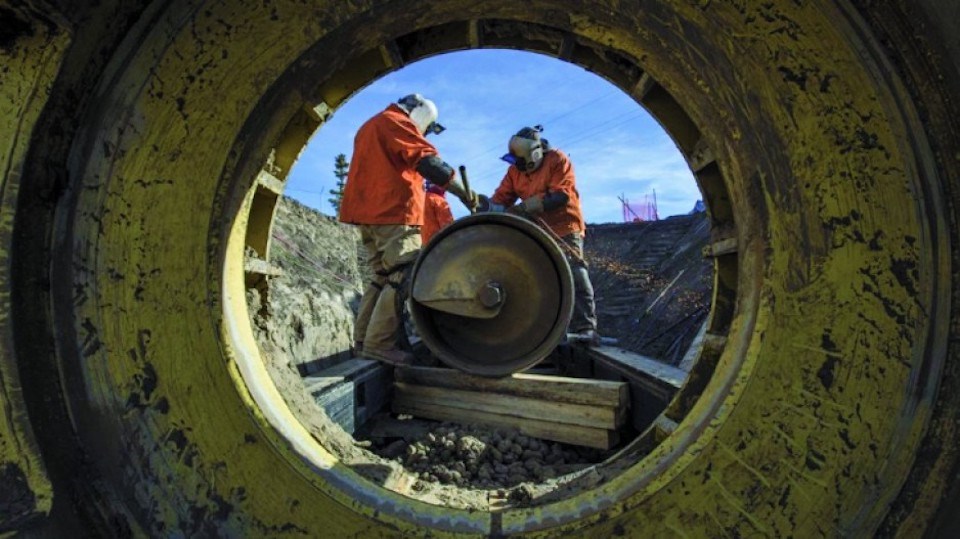Oil and gas companies in the U.S. and Canada have been slammed by politicians on both sides of the border for reaping massive profits on high oil and natural gas prices, and rewarding shareholders, rather than reinvesting.
But capital investments in Western Canada’s natural gas sector have picked up this year and are expected to increase over the next few years, in anticipation of increased demand from new liquefied natural gas (LNG) projects in B.C. and the U.S.
Two natural gas producers in B.C. now have long-term contracts to supply gas to the U.S. Gulf Coast for LNG exports, which will require increased upstream production.
The Alberta Energy Regulator projected capital spending on oil and gas to increase to $17 billion this year, which would be a 56 per cent increase over 2021.
“This year’s been a really banner year for gas development,” said Ian Archer, associate director of commodity insights for S&P Global. “We’ve seen very strong growth in Western Canadian production.”
Enbridge Inc. (TSX,NYSE:ENB) recently announced that it plans to invest between $3.6 billion and $5.5 billion to expand its natural gas pipelines in B.C. This suggests the Montney formation in northeastern B.C. will continue to be a significant gas-producing region for decades and will continue to draw billions in investment, thanks to new LNG projects expected to come online soon in B.C. and the U.S.
Enbridge plans to spend $3.6 billion to expand its T-South pipeline, which runs from Chetwynd to the Lower Mainland and the U.S. border. The expansion would increase the pipeline’s gas capacity by 300 million cubic feet per day (MMcf/d). The company plans to submit an application for the expansion to the Canadian Energy Regulator (CER) in 2024.
It also plans to gauge producers’ interest in additional capacity on its T-North line, which runs from the Fort Nelson region to Alberta and ties into the T-South line. If there is sufficient demand from producers and shippers, the company would invest an additional $1.9 billion to expand the T-North line.
Enbridge isn’t the only midstream company with expansion plans. NorthRiver Midstream has applied to the CER for a new project, the North East B.C. Connector, which is a 215-kilometre twin pipeline that would run from B.C. to Alberta. That project is driven more by the natural gas liquids market than LNG. One pipeline would be for condensate – a type of light oil used to dilute bitumen. The other would be for other natural gas liquids.
According to the BC Oil and Gas Commission (BOGC), there were 310 new wells drilled in B.C. in 2022, and drilling can expected to ramp up over the next couple of years, provided the B.C. government and Blueberry River First Nation can agree on land-use issues in the region. Permitting new wells in B.C. has been on pause due to a court case that found that years of industrial development in the Peace region constituted an infringement of Treaty 8 rights.
“When you look at investment plans of a lot of the majors, you see a lot of development plans going forward,” Archer said. “Some of this is related to LNG Canada, as well as potentially the startup of Woodfibre, which we anticipate to go ahead in 2027. That ties directly into both the T-South pipeline expansion as well as probably some of that T-North stuff that Enbridge is proposing.”
In B.C., LNG Canada is expected to be in production by mid-decade, and Woodfibre LNG in Squamish is aiming for production in 2027. Enbridge now has a 30 per cent stake in that project, estimated to cost $5.1 billion, which includes the cost of a new pipeline connection that FortisBC is building for the project.
Two other proposed LNG projects moving through the regulatory process in B.C. are Cedar LNG in Kitimat and Ksi Lisims in Prince Rupert, and the partners behind LNG Canada may at some point sanction Phase 2 of their project. That alone would double the demand for natural gas to four billion cubic feet per day from two billion cubic feet per day.
Some of the natural gas produced in B.C. and Alberta will supply LNG exports from the U.S. Gulf Coast.
Two of the biggest players in B.C.’s Montney now have long-term contracts to supply Cheniere Energy (NYSE:LNG) with natural gas for its Corpus Christi LNG expansion through a network of Canadian and American natural gas mainlines.
Tourmaline Oil (TSX:TOU) has a 15-year agreement to supply Cheniere LNG with 140,000 million British thermal units (BTUs) of natural gas, according to the company’s November investor presentation.
Of the 545,000 barrels of oil equivalent per day (BOEPD) that Tourmaline expects to produce in 2023, the B.C. Montney accounts for nearly half: 220,000 to 240,000 BOEPD. The company plans to increase production to 700,000 BOEPD by 2028. A significant amount of that increased production will come from the B.C. Montney.
ARC Resources Ltd. (TSX:ARX) also has an offtake agreement with Cheniere LNG to supply 140,000 million BTUs of natural gas. And starting in 2026, ARC estimates 10 per cent of its production will be taken up by LNG Canada’s project.
ARC plans to spend $1.8 billion in 2023. About $575 million of that would be spent in B.C. on new wells, according to the company’s November investor presentation.
David Austin, a lawyer with Stirling Business Law who specializes in energy and electricity, said he hopes that the new natural gas infrastructure being built in B.C. will be electrified to bring greenhouse gas (GHG) emissions down.
“Any new infrastructure required to expand gas production in B.C., including pipelines, must be fully electrified,” he said. “The time for excuses has long since passed, including continuing to tout carbon capture and storage as the solution to greenhouse-gas reductions. When electricity is used for gas production and transportation, far fewer GHGs are emitted. Not a perfect solution but far better than the faint hope provided by financially unproven carbon capture and storage facilities.”



